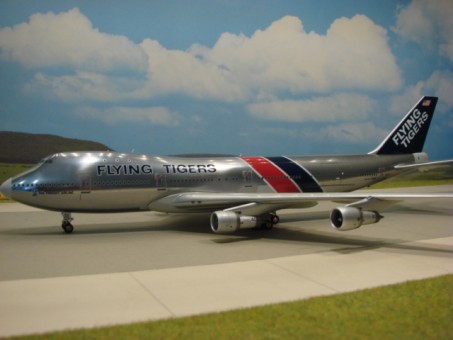Flying Tigers Boeing B747-132 (SF) w/ Stand Reg# N803FT IF7421015PA InFlight Model Scale 1:200
Highly detailed InFlight Model diecast model airplane. Flying Tigers Boeing B747-132 (SF) w/ Stand Reg# N803FT IF7421015PA InFlight Model Scale 1:200
Details
Highly detailed InFlight Model diecast model airplane
Flying Tigers Boeing B747-132 (SF) w/ Stand
Item#: IF7421015PA
Registration#: N803FT
Scale: 1:200
The 1st American Volunteer Group (AVG) of the Chinese Air Force in 1941–1942, nicknamed the Flying Tigers, comprised pilots from the United States Army Air Corps (USAAC), Navy (USN), and Marine Corps (USMC), recruited under presidential authority and commanded by Claire Lee Chennault. The shark-faced nose art of the Flying Tigers remains among the most recognizable image of any individual combat aircraft or combat unit of World War II.
The group comprise three fighter squadrons of around 30 aircraft each. It trained in Burma before the American entry into World War II with the mission of defending China against Japanese forces. The group of volunteers were officially members of the Chinese Air Force. The members of the group had contracts with salaries ranging from $250 a month for a mechanic to $750 for a squadron commander, roughly three times what they had been making in the U.S. forces. While it accepted some civilian volunteers for its headquarters and ground crew, the AVG recruited most of its staff from the U.S. military.
The group first saw combat on 20 December 1941, 12 days after Pearl Harbor (local time). It demonstrated innovative tactical victories when the news in the U.S. was filled with little more than stories of defeat at the hands of the Japanese forces, and achieved such notable success during the lowest period of the war for both the U.S. and the Allied Forces as to give hope to America that it might eventually defeat the Japanese. AVG pilots earned official credit, and received combat bonuses, for destroying 296 enemy aircraft, while losing only 14 pilots in combat. The combat records of the AVG still exist and researchers have found them credible[citation needed] . On 4 July 1942 the AVG was disbanded. It was replaced by the 23rd Fighter Group of the United States Army Air Forces, which was later absorbed into the U.S. Fourteenth Air Force with General Chennault as commander. The 23rd FG went on to achieve similar combat success, while retaining the nose art on the left-over P-40s.
Additional Info
-
Stock#IF7421015PA
-
BrandInFlight Models
-
Country of Manufacture
-
AircraftBoeing B747
-
AirlineFlying Tigers
-
RegistrationN803FT
-
MaterialN/A
-
Scale1:200
-
Dimensions (L x W)No
Warning: Choking Hazard!
Contains small parts. Not a toy. Not for children under 3 years.
You may also be interested in the following product(s)





